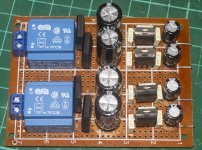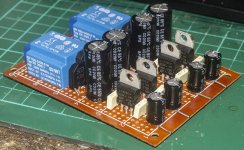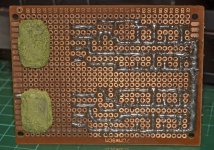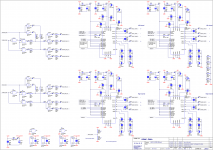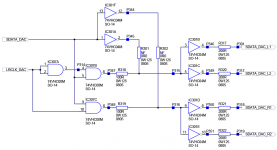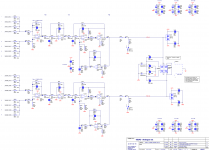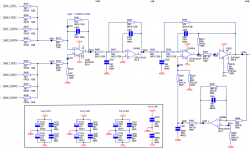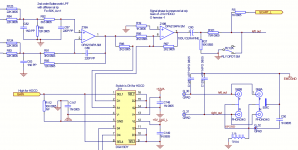It's not as simple as that.
I'm splitting the digital and analogue supplies for each WM8740, which means four supply rails.
From the WM8740 datasheet:
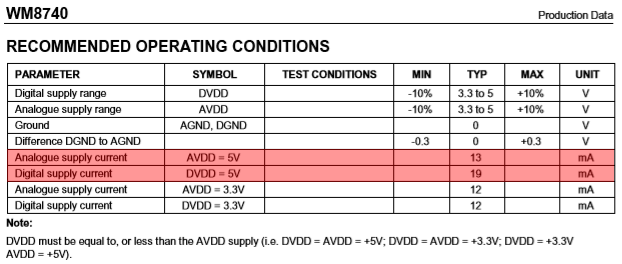
So we have four lines:
1. WM8740 A AVDD - consumes 13mA typical
2. WM8740 A DVDD - consumes 19mA typical
3. WM8740 B AVDD - consumes 13mA typical
4. WM8740 B DVDD - consumes 19mA typical
There will be a 7805 regulating each line, so add 5mA to the consumption:
1. 18mA
2. 24mA
3. 18mA
4. 24mA
The tiny trafos I'm using are ERA EE20/6.1 0.35VA part number 020-5429.0
Here is the datasheet:
EE20/6.1 0.35VA
Which states the output of each secondary is 6v at 29mA.
So I think I've got lucky and the 29mA output is just enough.
Lesson learned though - always read all the datasheets and plan everything out in detail before purchasing parts.
I'm splitting the digital and analogue supplies for each WM8740, which means four supply rails.
From the WM8740 datasheet:
So we have four lines:
1. WM8740 A AVDD - consumes 13mA typical
2. WM8740 A DVDD - consumes 19mA typical
3. WM8740 B AVDD - consumes 13mA typical
4. WM8740 B DVDD - consumes 19mA typical
There will be a 7805 regulating each line, so add 5mA to the consumption:
1. 18mA
2. 24mA
3. 18mA
4. 24mA
The tiny trafos I'm using are ERA EE20/6.1 0.35VA part number 020-5429.0
Here is the datasheet:
EE20/6.1 0.35VA
Which states the output of each secondary is 6v at 29mA.
So I think I've got lucky and the 29mA output is just enough.
Lesson learned though - always read all the datasheets and plan everything out in detail before purchasing parts.
Seeing as I had four 7805s in my parts stash, I used them to complete these mini PSUs.
I put a 0.1uF polypropylene either side of the 7805 and a 220uF on the output. I joined all four earths together and ran the four +5v lines above the PCB as output pins.
I put a 0.1uF polypropylene either side of the 7805 and a 220uF on the output. I joined all four earths together and ran the four +5v lines above the PCB as output pins.
Attachments
if you put 0,1 uF // to the 220 uf at the outputt of those regs, just leave it off. It's ok at the input only. you can putt the 0,1 uf though on the load legs of course. Let your ears decide at the end.
Cheers iggy. Now I've put it there (the 0.1uF) I'll leave it there, I don't think it will do any harm.
Yes let you ears decide, in my long experience with cd players tweaking from 20 years however it is often a problem, as it introduces an oscilation, you wantr more the high Z of the 220 uf caps and not the 0,1 uF faster MKT or film // with it , which at the oposite is what you want in the input leg as the lowest ESR cap... silmic 2, Nich Kz, etc.
Being there with tons of cd players, most of them Philips Marantz , Pioneer, TEAC, Aiwas (not knew enough imho)...
Being there with tons of cd players, most of them Philips Marantz , Pioneer, TEAC, Aiwas (not knew enough imho)...
Last edited:
Oh, so the 0.1uF after the 7805 might introduce oscillation?
I shall keep that in mind and if it does, it is a quick job to remove it.
Thankyou for the advice, much appreciated.
I shall keep that in mind and if it does, it is a quick job to remove it.
Thankyou for the advice, much appreciated.
what you want with such 78xx, 75xx, 79XX is to introduce at the output a higher Z. you have several ways to do it. long traces between those regs outputs and the load, a small resistor or a cap that is making both a regulated reservoir cap and that introduce some Z if used because when agieing, ESR is falling and it's what you want here.
However at the ebnd of the line it's indeed good to remove big caps if not needed now but decouple with a little value. So the 0,1 uf is ok but more at the pins of the load. I found sometimes very few exceptionss in some cd players with those regs in the 80s, 90s, 2000s when they were used a lot.
Try both and let your ears decide. Try & errors with a lot of work an,d checks also works and is fine as it's often more acurate against what we beleive to rule or know....
I permit myself to testimony here as I tweaked dozen and dozen of cd players before Lampizator was known, and of course broken dozen and dozen to learn, gloups, glad the dac chips are more solid that rom registries....
However at the ebnd of the line it's indeed good to remove big caps if not needed now but decouple with a little value. So the 0,1 uf is ok but more at the pins of the load. I found sometimes very few exceptionss in some cd players with those regs in the 80s, 90s, 2000s when they were used a lot.
Try both and let your ears decide. Try & errors with a lot of work an,d checks also works and is fine as it's often more acurate against what we beleive to rule or know....
I permit myself to testimony here as I tweaked dozen and dozen of cd players before Lampizator was known, and of course broken dozen and dozen to learn, gloups, glad the dac chips are more solid that rom registries....
Oh, so the 0.1uF after the 7805 might introduce oscillation?
I shall keep that in mind and if it does, it is a quick job to remove it.
How will you know without a scope? The oscillation might at 1MHz...
But if it affects the sound, then it would be audible. or am I missing the point?
I know an oscilloscope is a good thing to have, but I have to work with what I have at the moment, a scope is something I will acquire eventually, but not at the moment.
I looked at the service manual for the ARCAM CD192 which uses four WM8740s and noticed that the power supply arrangements for the WM8740s are different, it uses a 3.3v digital line and three 5v analogue lines, which seems to be the best possible power supply arrangement for this DAc, so I'm thinking this is what I should implement.
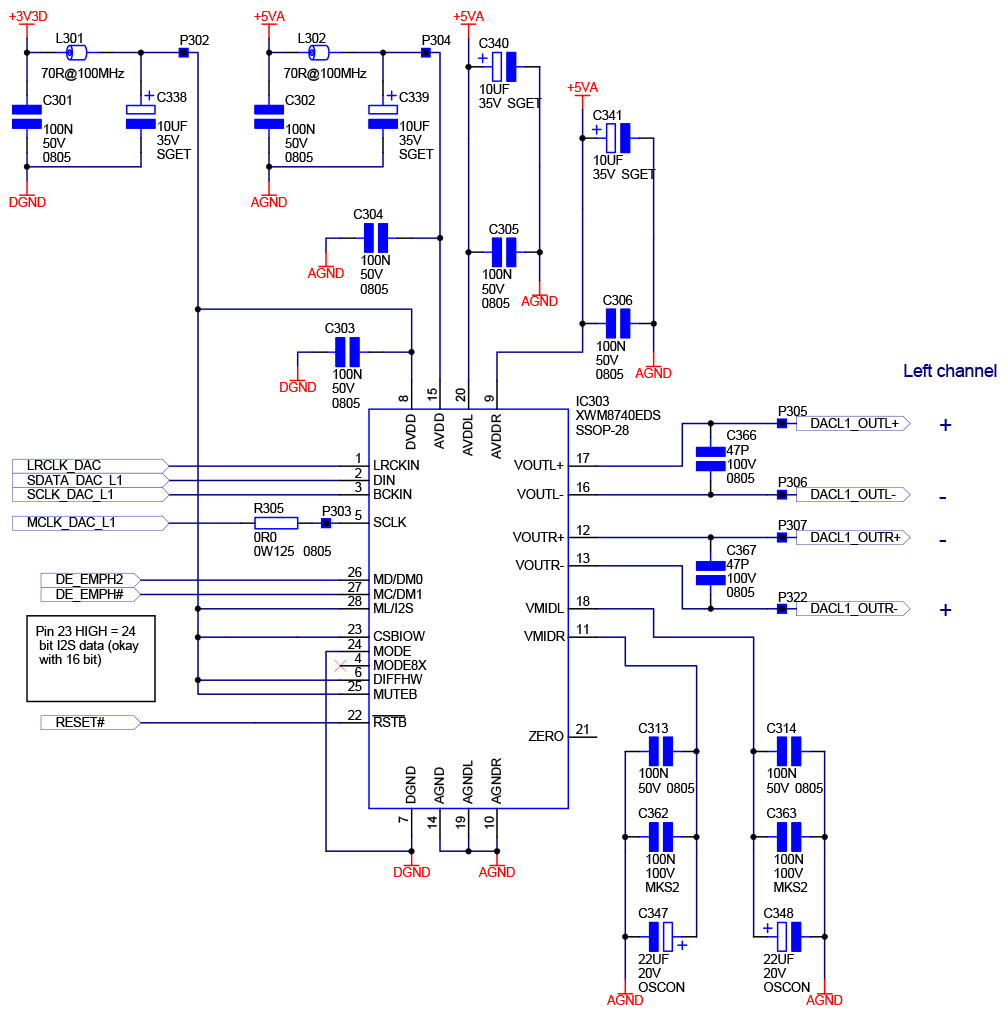
I know an oscilloscope is a good thing to have, but I have to work with what I have at the moment, a scope is something I will acquire eventually, but not at the moment.
I looked at the service manual for the ARCAM CD192 which uses four WM8740s and noticed that the power supply arrangements for the WM8740s are different, it uses a 3.3v digital line and three 5v analogue lines, which seems to be the best possible power supply arrangement for this DAc, so I'm thinking this is what I should implement.
Attachments
You might not know there was an audible problem unless you A/B compared with and without the oscillation. It wouldn't necessarily be a type of distortion you would recognize as a distortion unless you had some experience with it before. You might think the sound is the way it is because of the recording, because of the dac chips, because of your amplfier, etc. People often have no clue there is a problem unless someone shows them what the the difference in sound is.
Just out of interest, here's how ARCAM implemented four WM8740s - 2 per channel. The WM8740 has a dual differential mode, which enables them to be used in a pair, one per channel, but two per channel, how is that possible?
ARCAM have used 74VHS04M and 74VHC00M hex inverters:
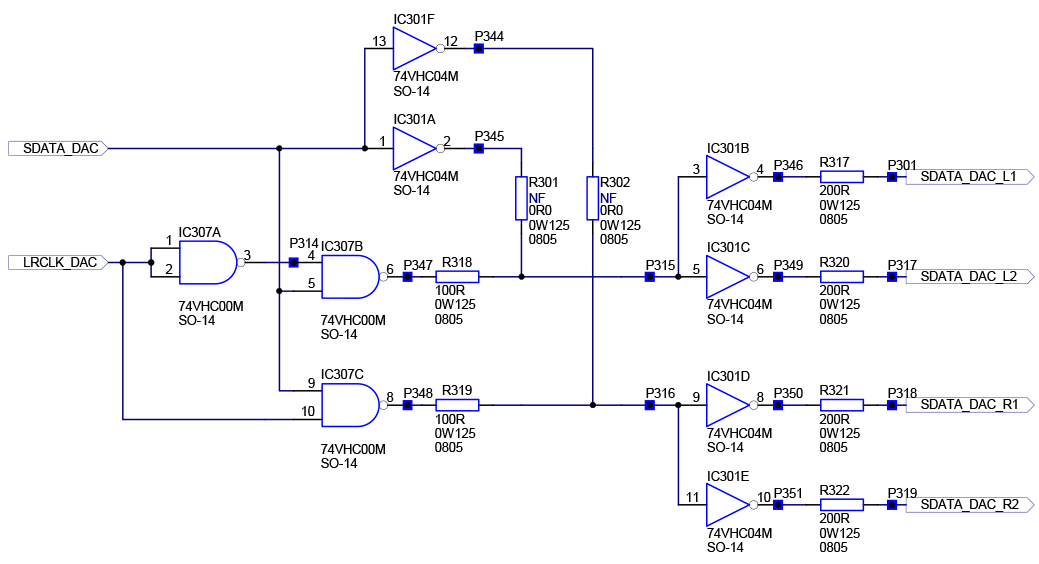
I don't know their rationale for doing this that way, why four WM8740s would be better than two.
There must be a good reason for doing so as they used four WM8740s in their TOTL CD players:
ARCAM DIVA CD72 - PCM1716
ARCAM DIVA CD73T - WM8740
ARCAM DIVA CD82 - 2 x WM8740s
ARCAM DIVA CD92 - dCS RingDAC 24bit + PMD200
ARCAM DIVA CD93 - 4 x WM8740s
ARCAM DIVA CD192 - 4 x WM8740s
ARCAM FMJ CD17 - WM8741
ARCAM FMJ CD23T - dCS RingDAC + HDCD
ARCAM FMJ CD33 - 4 x WM8740 – AD1896A
ARCAM FMJ CD36 - 4 x WM8740 – AD1896A
ARCAM FMJ CD37 – WM8741
ARCAM have used 74VHS04M and 74VHC00M hex inverters:
I don't know their rationale for doing this that way, why four WM8740s would be better than two.
There must be a good reason for doing so as they used four WM8740s in their TOTL CD players:
ARCAM DIVA CD72 - PCM1716
ARCAM DIVA CD73T - WM8740
ARCAM DIVA CD82 - 2 x WM8740s
ARCAM DIVA CD92 - dCS RingDAC 24bit + PMD200
ARCAM DIVA CD93 - 4 x WM8740s
ARCAM DIVA CD192 - 4 x WM8740s
ARCAM FMJ CD17 - WM8741
ARCAM FMJ CD23T - dCS RingDAC + HDCD
ARCAM FMJ CD33 - 4 x WM8740 – AD1896A
ARCAM FMJ CD36 - 4 x WM8740 – AD1896A
ARCAM FMJ CD37 – WM8741
Attachments
Last edited:
Some dacs boards use two dac or more chips per channel. There are different ways of doing it. Sometimes two dacs are operated in parallel to get more output current. Sometimes one dac chip reproduces the top half of the waveform and the other dac reproduces the bottom half. Parallel is probably more common.
The output stage of the CD192 is also more complex, it uses three opamps - an AD797, an OPA2134s and a BUF634 per channel, with three +12v supplies per channel plus another OPA2134 with it's own +12v supply shared by both channels.
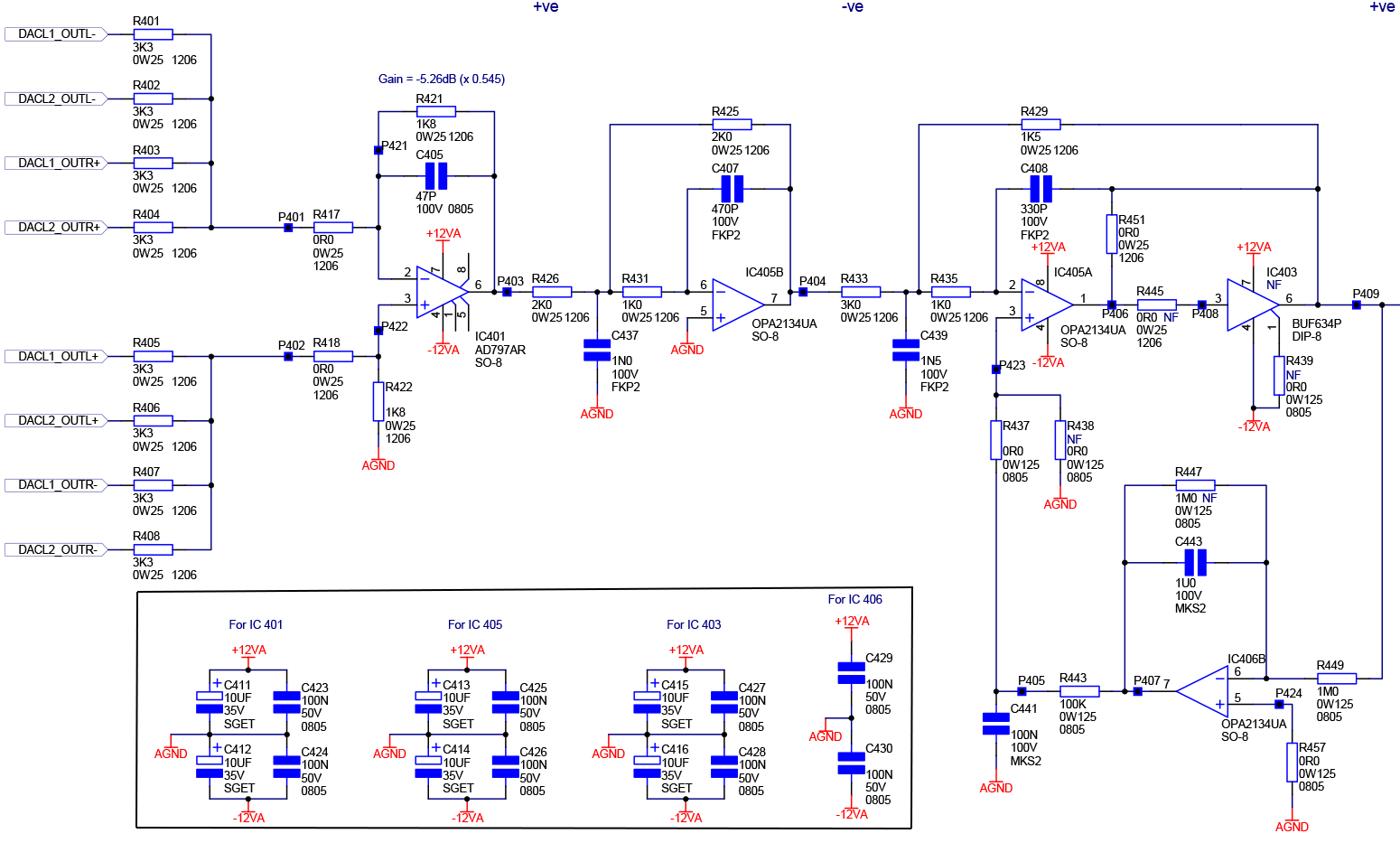
Attachments
Last edited:
You might not know there was an audible problem unless you A/B compared with and without the oscillation. It wouldn't necessarily be a type of distortion you would recognize as a distortion unless you had some experience with it before. You might think the sound is the way it is because of the recording, because of the dac chips, because of your amplfier, etc. People often have no clue there is a problem unless someone shows them what the the difference in sound is.
well said.
I often tweak dac device by pair, btw, to have a reference and use more or less the same big list of recordings since 10 to 20 years now. The problem with scope is imho that they are a must but not enough, and unluckily the eyes can bias the ears, as it's not exactly the same parts of your mind that decide which sounds best at the end since you have been biased by an information - btw it works in either direction : ears can be wrong and judge a visual/brain rational information which can be correct- One must be very careful imho.
Ah this was T&A in Germany that spited ,the frequency range with two dac chips iirc ! Wolfson are almost not beaten when it comes to the low register bass area iirc... while you want to avoid it above where many brands "shine" way better in the mid treble area.
OMG, never liked those 2134 oaps, there is something hard and not musical with them, thouigh they are surounded by many others oaps in that shematic...797 is quite good... Buf634, you may love it or not... is it here for headphones purposes or just to drive complex load that should be here in the customer owner ?
Last edited:
I don't know why the output stages of the ARCAM DV88 and CD192 are so different. The CD192 is much more complex and was the TOTL player of the DIVA range (since replaced with the FMJ range) but IMHO, complex is often not better.
one channel of CD192 output stage:
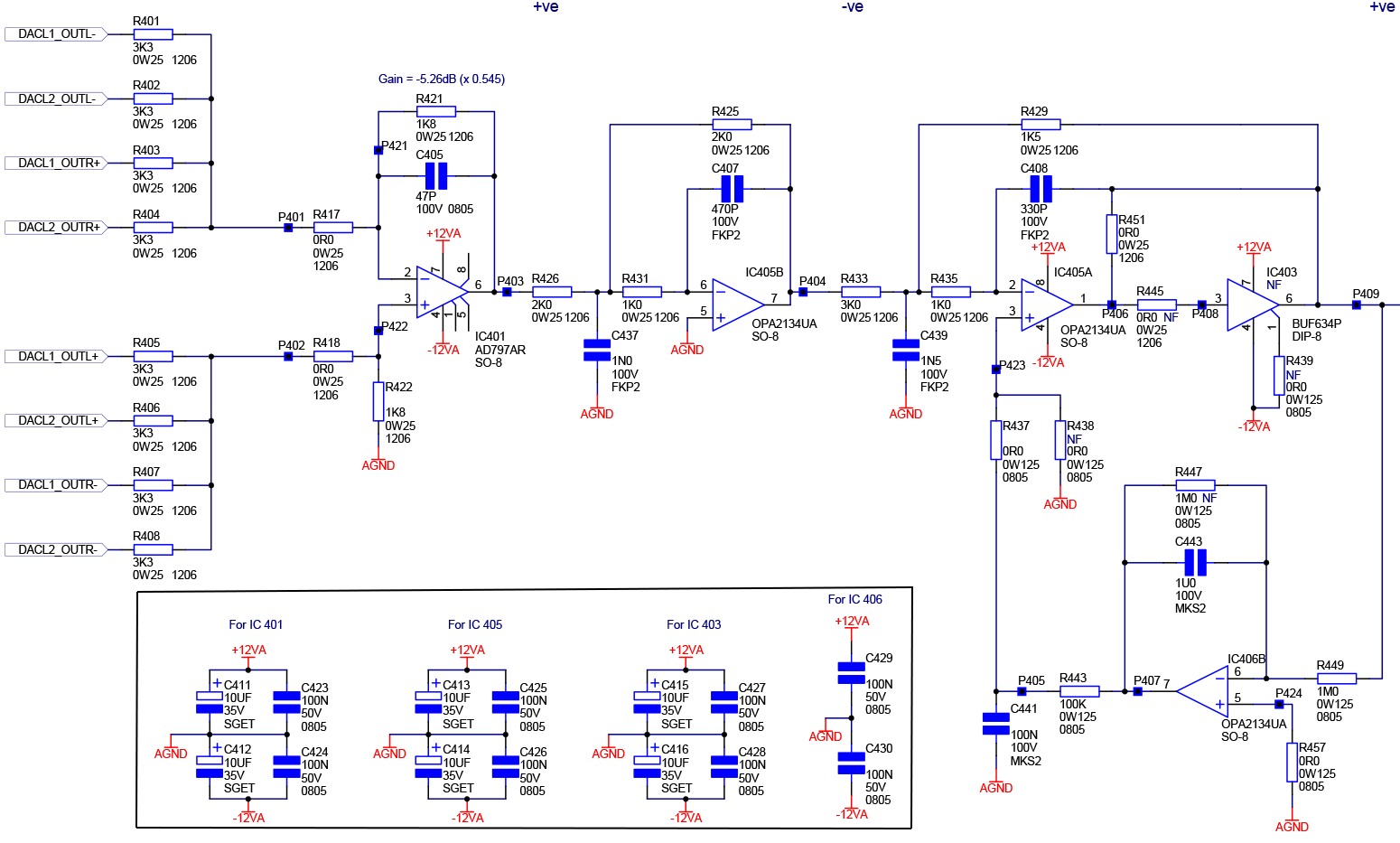
one channel of DV88 output stage:
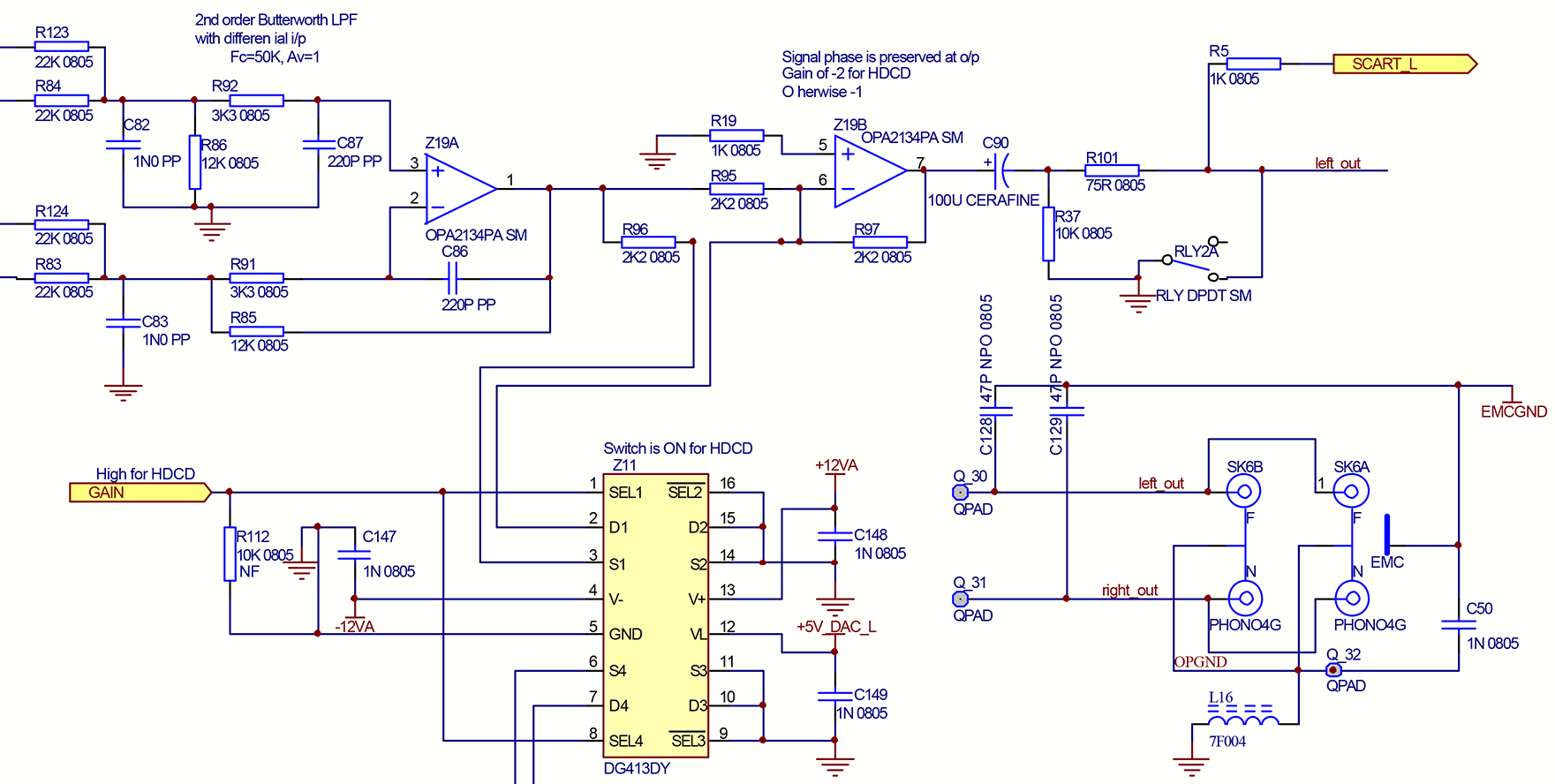
one channel of CD192 output stage:
one channel of DV88 output stage:
Attachments
The first schematic kind of looks like they are trying to maximize the stereo separation between the L/R channels. IIUC they are trying to cancel out center information to emphasize information unique to each channel. Could be the dac chips don't have great channel separation on their own.
Sometimes one dac chip reproduces the top half of the waveform and the other dac reproduces the bottom half.
I have seen this dubious notion put about a number of times and I can only conclude its proponents have not given it much thought.
- Home
- Source & Line
- Digital Line Level
- CD player upgrade project
